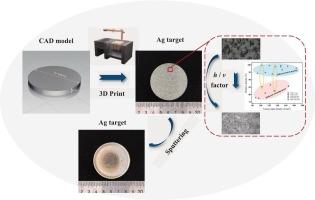激光粉末床熔镀纯银溅射靶:工艺、显微结构和溅射性能
IF 7.9
2区 材料科学
Q1 MATERIALS SCIENCE, MULTIDISCIPLINARY
引用次数: 0
摘要
银(Ag)溅射靶在电子信息材料中至关重要,特别是随着人工智能(AI)的快速发展,这进一步增加了对银(Ag)溅射靶的需求。然而,纯银在红外范围内的极高反射率和较差的激光吸收使得使用传统的基于激光的增材制造(AM)系统进行加工具有挑战性,限制了其广泛应用。在这项研究中,提出了一种新的以舱口间距-扫描速度比(h/v)为中心的低能量密度策略,以克服这一挑战,实现高质量的纯银增材制造。通过优化(h/v)值至1.0E-04,我们在不增加能量输入的情况下成功制备了致密、低缺陷的银溅射靶材。结果表明,该方法显著缩短了制备周期,制备出晶粒细(3 ~ 7 μm)、密度高(≥99.8%)、表面光滑(Ra = 11.5 μm)、溅射性能稳定(溅射速率= 31.8 nm/min)的高性能银靶。与传统方法制备的银靶相比,硬度提高了45.1%。这项工作为在高反射金属溅射目标的生产中应用激光增材制造提供了一条实用的途径,促进了其在薄膜电子领域的工业化,同时也有助于理解金属材料中的增材制造工艺结构关系。本文章由计算机程序翻译,如有差异,请以英文原文为准。

Laser powder bed fusion of pure silver sputtering target: process, microstructure, and sputtering performance
Silver (Ag) sputtering targets are crucial in electronic information materials, particularly with the rapid advancement of Artificial Intelligence (AI), which has further increased their demand. However, the extremely high reflectivity and poor laser absorption of pure Ag in the infrared range make it challenging to process using conventional laser-based Additive Manufacturing (AM) systems, limiting its wide application. In this study, a novel hatch spacing-to-scanning speed ratio (h/v)-centered low-energy–density strategy was proposed to overcome this challenge and enable high-quality additive manufacturing of pure Ag. By optimizing the (h/v) value to 1.0E-04, we successfully fabricated dense, low-defect Ag sputtering targets without increasing energy input. The results demonstrated that this method significantly shortened the manufacturing cycle and produced high-performance Ag targets with refined grains (3–7 μm), high density (≥99.8 %), a smooth surface (Ra = 11.5 μm), and stable sputtering performance (sputtering rate = 31.8 nm/min). Furthermore, the hardness increased by 45.1 % compared to Ag targets prepared by traditional methods. This work offers a practical pathway for applying laser-based AM in the production of highly reflective metal sputtering targets, advancing their industrialization in thin-film electronics, while also contributing to the understanding of AM process–structure relationships in metallic materials.
求助全文
通过发布文献求助,成功后即可免费获取论文全文。
去求助
来源期刊

Materials & Design
Engineering-Mechanical Engineering
CiteScore
14.30
自引率
7.10%
发文量
1028
审稿时长
85 days
期刊介绍:
Materials and Design is a multi-disciplinary journal that publishes original research reports, review articles, and express communications. The journal focuses on studying the structure and properties of inorganic and organic materials, advancements in synthesis, processing, characterization, and testing, the design of materials and engineering systems, and their applications in technology. It aims to bring together various aspects of materials science, engineering, physics, and chemistry.
The journal explores themes ranging from materials to design and aims to reveal the connections between natural and artificial materials, as well as experiment and modeling. Manuscripts submitted to Materials and Design should contain elements of discovery and surprise, as they often contribute new insights into the architecture and function of matter.
 求助内容:
求助内容: 应助结果提醒方式:
应助结果提醒方式:


